
A corona is an aura of plasma that surrounds the Sun and other stars. The Sun's corona extends millions of kilometres into outer space and is most easily seen during a total solar eclipse, but it is also observable with a coronagraph. Spectroscopy measurements indicate strong ionization in the corona and a plasma temperature in excess of 1000000 kelvin, much hotter than the surface of the Sun.

X-ray astronomy is an observational branch of astronomy which deals with the study of X-ray observation and detection from astronomical objects. X-radiation is absorbed by the Earth's atmosphere, so instruments to detect X-rays must be taken to high altitude by balloons, sounding rockets, and satellites. X-ray astronomy uses a type of space telescope that can see x-ray radiation which standard optical telescopes, such as the Mauna Kea Observatories, cannot.

A solar flare is a sudden flash of increased brightness on the Sun, usually observed near its surface and in close proximity to a sunspot group. Powerful flares are often, but not always, accompanied by a coronal mass ejection. Even the most powerful flares are barely detectable in the total solar irradiance.
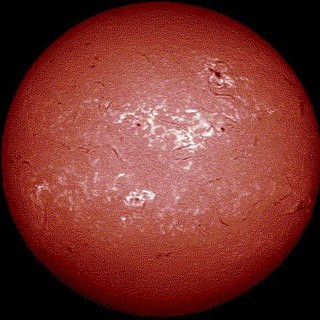
The chromosphere is the second of the three main layers in the Sun's atmosphere and is roughly 3,000 to 5,000 kilometers deep. Its rosy red color is only apparent during eclipses. The chromosphere sits just above the photosphere and below the solar transition region. The layer of the chromosphere atop the photosphere is homogeneous. A forest of hairy-appearing spicules rise from the homogeneous layer, some of which extend 10,000 km into the corona above.

A coronal mass ejection (CME) is a significant release of plasma and accompanying magnetic field from the solar corona. They often follow solar flares and are normally present during a solar prominence eruption. The plasma is released into the solar wind, and can be observed in coronagraph imagery. The term "mass" in the name doesn't refer to the size but instead that mass is being ejected rather than just photons, as smaller solar flares often only release.
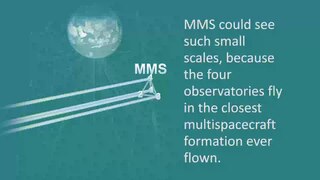
In plasma physics, an Alfvén wave, named after Hannes Alfvén, is a type of magnetohydrodynamic wave in which ions oscillate in response to a restoring force provided by an effective tension on the magnetic field lines.

Magnetic reconnection is a physical process occurring in highly conducting plasmas in which the magnetic topology is rearranged and magnetic energy is converted to kinetic energy, thermal energy, and particle acceleration. Magnetic reconnection occurs on timescales intermediate between slow resistive diffusion of the magnetic field and fast Alfvénic timescales.
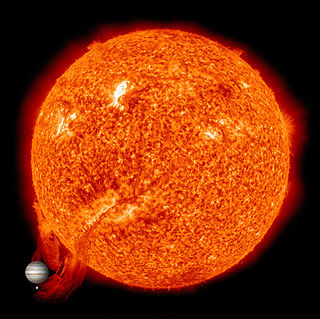
A prominence, referred to as a filament when viewed against the solar disk, is a large, bright, gaseous feature extending outward from the Sun's surface, often in a loop shape. Prominences are anchored to the Sun's surface in the photosphere, and extend outwards into the solar corona. While the corona consists of extremely hot ionized gases, known as plasma, which do not emit much visible light, prominences contain much cooler plasma, similar in composition to that of the chromosphere. The prominence plasma is typically a hundred times more luminous and dense than the coronal plasma.
Eric Ronald Priest is Emeritus Professor at St Andrews University, where he previously held the Gregory Chair of Mathematics and a Bishop Wardlaw Professorship.

Coronal loops are huge loops of magnetic field beginning and ending on the Sun's visible surface (photosphere) projecting into the solar atmosphere (corona). Hot glowing ionized gas (plasma) trapped in the loops makes them visible. Coronal loops range widely in size up to several thousand kilometers long. They are transient features of the solar surface, forming and dissipating over periods of seconds to days. They form the basic structure of the lower corona and transition region of the Sun. These highly structured loops are a direct consequence of the twisted solar magnetic flux within the solar body. Coronal loops are associated with sunspots; the two "footpoints" where the loop passes through the sun's surface are often sunspots. This is because sunspots occur at regions of high magnetic field. The high magnetic field where the loop passes through the surface forms a barrier to convection currents, which bring hot plasma from the interior to the sun's surface, so the plasma in these high field regions is cooler than the rest of the sun's surface, appearing as a dark spot when viewed against the rest of the photosphere. The population of coronal loops varies with the 11 year solar cycle, which also influences the number of sunspots.
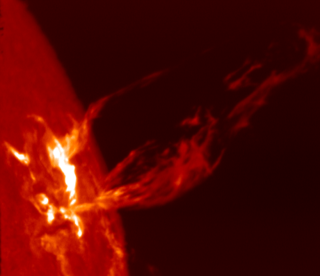
A stellar magnetic field is a magnetic field generated by the motion of conductive plasma inside a star. This motion is created through convection, which is a form of energy transport involving the physical movement of material. A localized magnetic field exerts a force on the plasma, effectively increasing the pressure without a comparable gain in density. As a result, the magnetized region rises relative to the remainder of the plasma, until it reaches the star's photosphere. This creates starspots on the surface, and the related phenomenon of coronal loops.

Aditya or Aditya-L1 is a planned coronagraphy spacecraft to study solar atmosphere, currently being designed and developed by Indian Space Research Organisation (ISRO) and various other Indian research institutes. It will be inserted in a halo orbit around the L1 point between Earth and Sun where it will study solar atmosphere, solar magnetic storms and it's impact on environment around Earth.
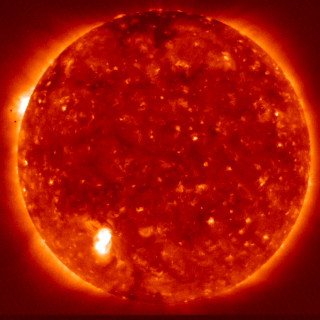
In astronomy and in astrophysics, for radiative losses of the solar corona, it is meant the energy flux radiated from the external atmosphere of the Sun, and, in particular, the processes of production of the radiation coming from the solar corona and transition region, where the plasma is optically-thin. On the contrary, in the chromosphere, where the temperature decreases from the photospheric value of 6000 K to the minimum of 4400 K, the optical depth is about 1, and the radiation is thermal.
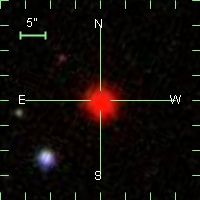
AZ Cancri (AZ Cnc) is a M-type flare star in the constellation Cancer. It has an apparent visual magnitude of approximately 17.59.
The Neupert effect refers to an empirical tendency for high-energy ('hard') X-ray emission to coincide temporally with the rate of rise of lower-energy ('soft') X-ray emission of a solar flare. Here 'hard' and 'soft' mean above and below an energy of about 10 keV to solar physicists, though in non-solar X-ray astronomy one typically sets this boundary at a lower energy.

Solar phenomena are the natural phenomena occurring within the magnetically heated outer atmospheres in the Sun. These phenomena take many forms, including solar wind, radio wave flux, energy bursts such as solar flares, coronal mass ejection or solar eruptions, coronal heating and sunspots.

Supra-arcade downflows (SADs) are sunward-traveling plasma voids that are sometimes observed in the Sun's outer atmosphere, or corona, during solar flares. In solar physics, an “arcade” refers to a bundle of coronal loops, and the prefix “supra” indicates that the downflows appear above flare arcades. They were first described in 1999 using the Soft X-ray Telescope (SXT) on board the Yohkoh satellite. SADs are byproducts of the magnetic reconnection process that drives solar flares, but their precise cause remains unknown.
Jiong Qiu (邱炯) is a Chinese-born American astrophysicist who won the Karen Harvey Prize for her work in solar flares.
Philippa K. Browning is a Professor of Astrophysics in the Jodrell Bank Centre for Astrophysics at the University of Manchester. She specialises in the mathematical modelling of fusion plasmas.
Solar radio emission refers to radio waves that are naturally produced by the Sun, primarily from the lower and upper layers of the atmosphere called the chromosphere and corona, respectively. The Sun produces radio emissions through four known mechanisms, each of which operates primarily by converting the energy of moving electrons into radiation. The four emission mechanisms are thermal bremsstrahlung (free-free) emission, gyromagnetic emission, plasma emission, and electron-cyclotron maser emission. The first two are incoherent mechanisms, which means that they are the summation of radiation generated independently by many individual particles. These mechanisms are primarily responsible for the persistent "background" emissions that slowly vary as structures in the atmosphere evolve. The latter two processes are coherent mechanisms, which refers to special cases where radiation is efficiently produced at a particular set of frequencies. Coherent mechanisms can produce much larger brightness temperatures (intensities) and are primarily responsible for the intense spikes of radiation called solar radio bursts, which are byproducts of the same processes that lead to other forms of solar activity like solar flares and coronal mass ejections.



















